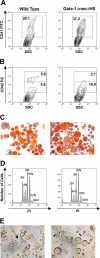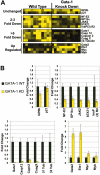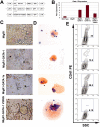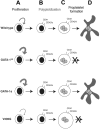Differential requirements for the activation domain and FOG-interaction surface of GATA-1 in megakaryocyte gene expression and development
- PMID: 15860665
- PMCID: PMC1895209
- DOI: 10.1182/blood-2005-02-0551
Differential requirements for the activation domain and FOG-interaction surface of GATA-1 in megakaryocyte gene expression and development
Abstract
GATA1 is mutated in patients with 2 different disorders. First, individuals with a GATA1 mutation that blocks the interaction between GATA-1 and its cofactor Friend of GATA-1 (FOG-1) suffer from dyserythropoietic anemia and thrombocytopenia. Second, children with Down syndrome who develop acute megakaryoblastic leukemia harbor mutations in GATA1 that lead to the exclusive expression of a shorter isoform named GATA-1s. To determine the effect of these patient-specific mutations on GATA-1 function, we first compared the gene expression profile between wild-type and GATA-1-deficient megakaryocytes. Next, we introduced either GATA-1s or a FOG-binding mutant (V205G) into GATA-1-deficient megakaryocytes and assessed the effect on differentiation and gene expression. Whereas GATA-1-deficient megakaryocytes failed to undergo terminal differentiation and proliferated excessively in vitro, GATA-1s-expressing cells displayed proplatelet formation and other features of terminal maturation, but continued to proliferate aberrantly. In contrast, megakaryocytes that expressed V205G GATA-1 exhibited reduced proliferation, but failed to undergo maturation. Examination of the expression of megakaryocyte-specific genes in the various rescued cells correlated with the observed phenotypic differences. These studies show that GATA-1 is required for both normal regulation of proliferation and terminal maturation of megakaryocytes, and further, that these functions can be uncoupled by mutations in GATA1.
Figures





Similar articles
-
Transgenic rescue of GATA-1-deficient mice with GATA-1 lacking a FOG-1 association site phenocopies patients with X-linked thrombocytopenia.Blood. 2004 Apr 1;103(7):2560-7. doi: 10.1182/blood-2003-07-2514. Epub 2003 Dec 4. Blood. 2004. PMID: 14656885
-
Familial dyserythropoietic anaemia and thrombocytopenia due to an inherited mutation in GATA1.Nat Genet. 2000 Mar;24(3):266-70. doi: 10.1038/73480. Nat Genet. 2000. PMID: 10700180 Free PMC article.
-
Control of megakaryocyte-specific gene expression by GATA-1 and FOG-1: role of Ets transcription factors.EMBO J. 2002 Oct 1;21(19):5225-34. doi: 10.1093/emboj/cdf527. EMBO J. 2002. PMID: 12356738 Free PMC article.
-
Transcription factor GATA-1 in megakaryocyte development.Stem Cells. 1998;16 Suppl 2:79-83. doi: 10.1002/stem.5530160710. Stem Cells. 1998. PMID: 11012179 Review.
-
GATA transcription factors in hematologic disease.Int J Hematol. 2005 Jun;81(5):378-84. doi: 10.1532/ijh97.04180. Int J Hematol. 2005. PMID: 16158817 Review.
Cited by
-
Cross-talk of GATA-1 and P-TEFb in megakaryocyte differentiation.Blood. 2008 Dec 15;112(13):4884-94. doi: 10.1182/blood-2008-03-145722. Epub 2008 Sep 9. Blood. 2008. PMID: 18780834 Free PMC article.
-
GATA Transcription Factors and Cancer.Genes Cancer. 2010 Dec;1(12):1178-88. doi: 10.1177/1947601911404223. Genes Cancer. 2010. PMID: 21779441 Free PMC article.
-
Calpain 2 activation of P-TEFb drives megakaryocyte morphogenesis and is disrupted by leukemogenic GATA1 mutation.Dev Cell. 2013 Dec 23;27(6):607-20. doi: 10.1016/j.devcel.2013.11.013. Dev Cell. 2013. PMID: 24369834 Free PMC article.
-
Chromatin occupancy analysis reveals genome-wide GATA factor switching during hematopoiesis.Blood. 2012 Apr 19;119(16):3724-33. doi: 10.1182/blood-2011-09-380634. Epub 2012 Mar 1. Blood. 2012. PMID: 22383799 Free PMC article.
-
Dissecting molecular steps in chromatin domain activation during hematopoietic differentiation.Mol Cell Biol. 2007 Jun;27(12):4551-65. doi: 10.1128/MCB.00235-07. Epub 2007 Apr 16. Mol Cell Biol. 2007. PMID: 17438135 Free PMC article.
References
Publication types
MeSH terms
Substances
Grants and funding
LinkOut - more resources
Full Text Sources
Other Literature Sources
Molecular Biology Databases

